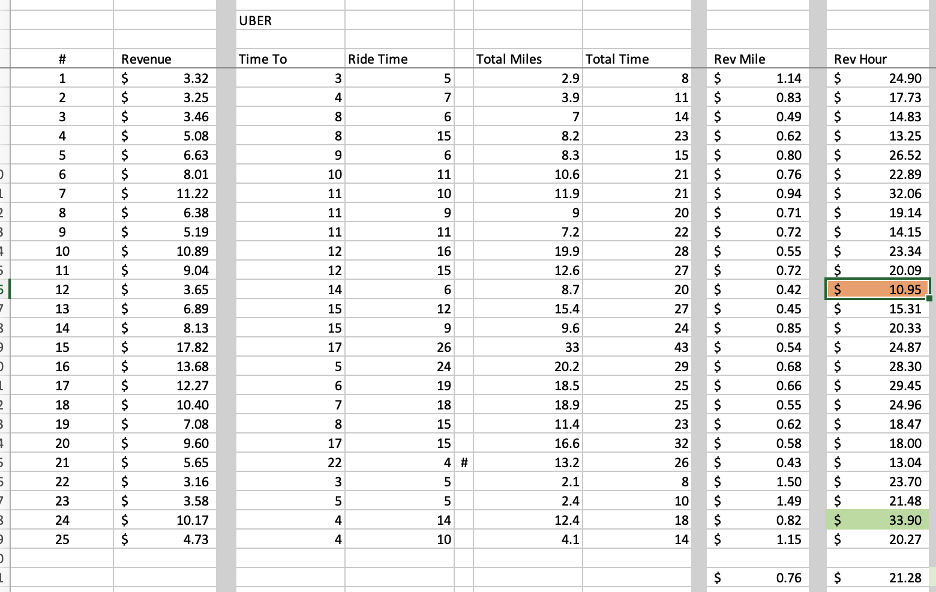Are Uber and Lyft paying you the same? For my entire career, I have assumed that Uber and Lyft both pay me the same amount of money.
Not too long ago, we, the drivers, could look up the rates that Uber and Lyft paid us. That seems fair!
Now, however, in the age of upfront pricing, those rate cards have disappeared. We are now victims to whichever algorithm happens to be working each day. This is a fluid situation.
The term being bandied about the internet is the Black Box (as in, we have no idea what is happening to our pay!).
In this article, I will share the results of my experiment to determine how much Uber pays me and how much Lyft pays me. I suggest you do the same.
Turns out one company pays me more per hour than the other. Let’s get into it!
Background
The only figure that matters to me is my dollars per hour.
In the past, earnings were a function of time and distance. Uber and Lyft paid a specified amount for each mile you drove with a passenger in your car, and for each minute you had a passenger in your car.
Drivers were not paid for the time and distance to go and pick up the passenger.
Now, all we see is an upfront revenue figure. In addition, we are also told the time and distance of the pickup and the ride.
Raw Data
I was certainly curious about how much I was getting paid per hour, but I was mostly interested in whether Uber and Lyft paid the same per-hour amount.
Before upfront pricing, I could look at the rate sheets and see that both were paying me the exact same amount.
Now with the black boxes in place, we don’t know if Uber’s black box functions like Lyft’s black box.
They certainly don’t share that information with us or with each other. The only way to know is to do your own investigation.
If one is paying me less than the other, then I should be more loyal to the one paying me the most.
I took screenshots of 25 rides for both companies. Here is what I came up with:
Uber
Here are screenshots of 25 rides I completed with Uber:

Lyft
Here are screenshots of 25 rides I completed with Lyft:

Crunching The Numbers
Next, I created two spreadsheets, one for Uber and one for Lyft.
Until I looked at these numbers, I had a feeling, simply based on my gut, that Uber was paying me more per ride.
I admit this was based on nothing more than a feeling, I have been driving more for Uber here in Sacramento. Uber also has offered slightly better bonuses which have further swayed me.
However, lately, Uber has been decreasing my bonus opportunities, most likely because I have been consistently driving for them.
This is how the black box algorithm works.
If Uber or Lyft see that I am consistent in one behavior, they will pay me a bit less and see if the behavior continues. If I keep doing the same thing, then (you guessed it) Uber and Lyft will pay me a little bit less.
Certainly, you must have noticed how your bonuses get smaller as you earn them. That’s not a mistake. It’s all a part of a plan to pay you less so Uber and Lyft can eventually show a profit.
Let’s see what the numbers show us.
Uber
In the Uber screenshot below, you can see a low of $10.95 per hour and a high of $33.90 per hour.
My average per hour with Uber was $21.28. This does not include surge, bonuses, or tips.

Related:
Lyft
In the Lyft screenshot below, you can see a low of $17.35 per hour and a high of $51.51 per hour.
My average per hour with Lyft was $25.41. This does not include surges, bonuses, or tips.

Related:
Comparison
- Lyft has a high of $51.51 vs Uber’s high of $33.90
- Lyft had a low of $17.35 vs Uber’s low of $10.95
- Lyft’s per hour was very strong at $25.41, compared to Uber’s $21.28
That is a 15% difference, which is huge! I was very surprised to see these results.
Given adequate bonuses from Lyft, I should be driving for Lyft. If I drove 40 hours a week for 50 weeks, the difference in earnings converts to over $8,000!
I suggest you start to do a similar analysis, especially if you are a full-time driver.
You might be surprised, as I was, that one company’s black box is paying you more than the other.
Related:
Key Takeaways
This was a real eye-opener for me. As I researched this article, I realized that unless you do something like this, you have no idea what Uber is paying you versus what Lyft is paying you.
Most of us have a choice between the two. After looking at 50 rides, it is clear that I should be driving more for Lyft.
This makes me smile as I have always preferred Lyft to Uber, and most of my 29,050 rides have been with Lyft.
The best thing besides higher pay is the auto-accept feature. I love that I don’t need to focus on my phone waiting for a ping as I do with Uber.
I will do something like this again in a few months to see if anything has changed. This is the world in which we live. Uber and Lyft can change our pay anytime they want to, and we will never know.
All we can know is how they paid us in the past. That will have to do for now.




